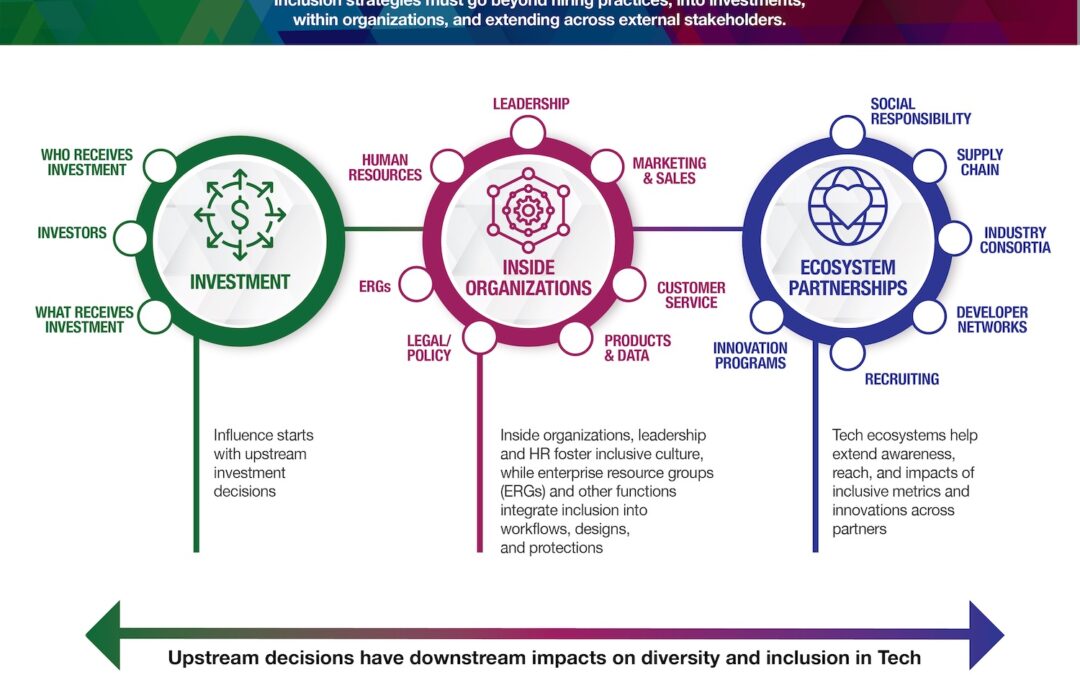Growing regulatory scrutiny and increased societal focus on structural inequities have spurred a boom in the Tech industry’s diversity and inclusion (D&I) programs and pledges. These pressures are forcing companies to reevaluate metrics around diversity, from the risks of homogeneity to the benefits of diversity on collaboration and innovation.
Yet despite investing millions in global “D&I” programs, many fall short:
- Making empty promises with little accountability or results to show
- Releasing incomplete diversity data and/or no benchmarking
- Hiring “token” D&I leads, but avoiding deeper systemic changes
- Pointing to “employee resource groups” (ERGs) without resourcing them for impact
- Over-emphasizing one group at the expense of others
- Existing D&I programs fly in the face of major discrimination lawsuits facing Tech companies
As part of our ongoing research in the future of work and digital trust, Kaleido Insights has been tracking the tech industry’s D&I strategies and efforts to improve equity. We’ve analyzed dozens of technology companies across the ecosystem for strengths and weaknesses, and analyzed why D&I in Tech is unique from other industries.
Key finding: Tech’s imperative to drive diversity and inclusion is unique because of its outsized influence in the global economy, other industries, and the nature of data-driven products and platforms.
The nature of big data-driven corporations, and their networked products and platforms, demands diversity and inclusivity far beyond hiring. Incorporating diverse viewpoints in technology decisions and designs isn’t just about avoiding risks, or even increasing market share, but about increasing equity and “growing the pie”– ever more important amidst an era characterized by technological acceleration and reckoning health, economic, racial equities.
When upstream investment, business, and product decisions by few determine diverse downstream consequences on many underrepresented groups, safeguards and inclusion must span a wide range of constituents across the value chain. Diversity and inclusion in Tech requires accountability in investment decisions, inside tech organizations and business functions, and externally via ecosystem partnerships.

Investment: Influence starts with investment decisions. Who has capital to invest? Who and what receive upstream investment opportunities often determines what sorts of ideas germinate into viable solutions. Tech investors and VC wield great influence (capital, referrals, and thought leadership) over the rest of the market, particularly as software pervades just about every other industry. (“Software is eating the world” as Marc Andreessen, co-founder and general partner of $16.6B venture capital firm Andreessen Horowitz famously declared)

Inside Organizations: Tech companies themselves must expand diversity efforts beyond HR. Hiring is important for expanding diversity within teams, but inadequate for integrating inclusive practices, protections, and workflows into day-to-day operations. This requires dedicated resourcing and feedback loops between leadership, HR, ERGs, and disparate business functions, where–crucially– each function understands its role in ensuring representation.
| Function | Role |
| Leadership | Sets values, priorities, and long-term inclusion strategy from the top; as the public face, can translate “feel good” brand narratives into investments, pledges, initiatives, metrics, allyship |
| Human Resources (HR) | Substantiates “inclusive culture” with company-wide efforts and policies, and integration via dedicated programs & practices across functions. |
| Enterprise Resource Groups (ERGs) | The critical liaisons to advise leadership, consult on product/service design, develop policies, create resources, and drive awareness and education; resourcing and empowerment of ERGs is key. |
| Product | Upstream product/platform design decisions determine many downstream impacts– accessibility, data representation, scale of impact, digital disenfranchisement and divide. |
| Marketing & Sales | Representation matters, and informs brand narratives, inclusive value propositions, competitive differentiation, and ecosystem relationships. |
| Customer Service | An untapped channel for humane brand and inclusive product experiences. |
| Legal/Policy | Helps Tech companies mitigate current discriminatory risks and identify emerging policy needs, both company and government policies. |
Ecosystem Partnerships: Tech companies are known for relying on ecosystems for resources, scale, innovation, or other value to the Tech company. We found these ecosystems are increasingly becoming part of companies’ D&I efforts on several fronts: supply chain networks, internships, Corporate Social Responsibility (CSR) efforts, developer and open source programs, and more. Ecosystems help Tech companies “see beyond their own walls,” and tap into knowledge, resources, cultures, and markets to which they are otherwise blind. The risk, however, is that they also afford companies brand benefits and CSR equity, without necessarily driving internal change.
Ultimately D&I must be more than narrative, it must be anchored in principles, policies, and practices integrated across the organization. To learn more about this research and how we’re helping clients drive greater equity and inclusion in Tech and digital transformation, contact us, or follow our ongoing coverage in our newsletter.

